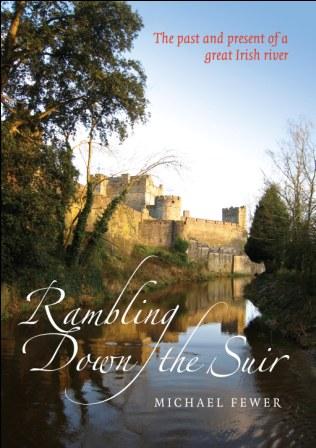 Unlike the rivers of England, Ireland’s great watercourses have been almost ignored in literature, and Michael Fewer has set out to address this lack in regard to the majestic river Suir. At 114 miles from its source in the Devil’s Bit Mountains in Co.Tipperary, to the sea, it is one of Ireland’s greatest rivers, and reckoned by many to be the second longest after the Shannon.
Unlike the rivers of England, Ireland’s great watercourses have been almost ignored in literature, and Michael Fewer has set out to address this lack in regard to the majestic river Suir. At 114 miles from its source in the Devil’s Bit Mountains in Co.Tipperary, to the sea, it is one of Ireland’s greatest rivers, and reckoned by many to be the second longest after the Shannon.
“Rambling Down the Suir” is an account of Michael Fewer’s exploration of the Suir, by aircraft, by boat, by car and on foot, as he follows the river’s course through space and time, meeting the people who populate its valley and its towns, examining its present and opening windows onto its past. A social, historical and photographic survey of of an Irish river of this sort has not been undertaken before, and therefore this work has a unique quality, although the tone and content is similar to the classic “Goodly Barrow: A Voyage on an Irish River” by T. F. O’Sullivan, first published in 1983, but re-printed a number of times since.
This publication is richly illustrated with colour photography and maps. The Suir played a critical and unique role in the colonisation the country, first by the Vikings in the 9th century, and a few centuries later by the Normans, who from their strongholds in riverine cities such as Waterford were to change the face of Ireland. The river continued to play a major role in the history of the country in every century since more English monarchs entered or left Ireland by way of the Suir and Waterford than by any other route.
The coming of the railways and modern road transport from the 19th century onwards moved economic emphasis away from rivers. The importance of the Suir as a water supply, as a main trading route connecting the hinterland with the seaport of Waterford, as an abundant source of fish, and as a source of waterpower is now a thing of the past, and in places its waters and banks have merged into the surrounding landscape, overgrown and almost forgotten. Along these stretches, relatively undeveloped and undisturbed by man, the flora and fauna of our increasingly intensely cultivated countryside have found asylum; species survive and thrive that are no longer common elsewhere. The sheer abundance of extant evidence of the Suir’s former importance is remarkable: the river valley has an impressive density of prehistoric monuments, earthworks, castles, abbeys and ruined churches, all quietly co-existing today with the 21st century agricultural busyness of some of the finest farmland in Ireland.
MICHAEL FEWER has been writing about leisure walking, travel, the countryside and environmental matters for two decades. He lives in Dublin, but these days spends an increasing amount of time in his native County Waterford. His previous book with Ashfield Press is The Wicklow Military Road, History and Topography (2007).
This book is a wine to be savoured at just €25 in paperback from Bookworm.

Leave a Reply